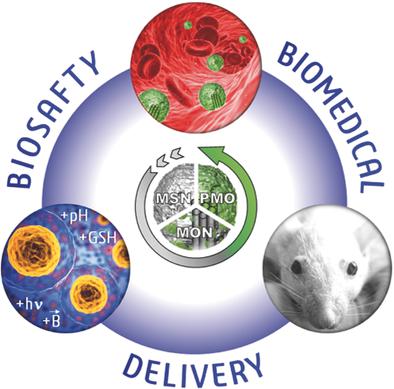当前位置:
X-MOL 学术
›
Adv. Healthcare Mater.
›
论文详情
Our official English website, www.x-mol.net, welcomes your
feedback! (Note: you will need to create a separate account there.)
Mesoporous Silica and Organosilica Nanoparticles: Physical Chemistry, Biosafety, Delivery Strategies, and Biomedical Applications
Advanced Healthcare Materials ( IF 10.0 ) Pub Date : 2017-11-30 , DOI: 10.1002/adhm.201700831 Jonas G. Croissant 1, 2 , Yevhen Fatieiev 3 , Abdulaziz Almalik 4 , Niveen M. Khashab 3
Advanced Healthcare Materials ( IF 10.0 ) Pub Date : 2017-11-30 , DOI: 10.1002/adhm.201700831 Jonas G. Croissant 1, 2 , Yevhen Fatieiev 3 , Abdulaziz Almalik 4 , Niveen M. Khashab 3
Affiliation

|
Predetermining the physico‐chemical properties, biosafety, and stimuli‐responsiveness of nanomaterials in biological environments is essential for safe and effective biomedical applications. At the forefront of biomedical research, mesoporous silica nanoparticles and mesoporous organosilica nanoparticles are increasingly investigated to predict their biological outcome by materials design. In this review, it is first chronicled that how the nanomaterial design of pure silica, partially hybridized organosilica, and fully hybridized organosilica (periodic mesoporous organosilicas) governs not only the physico‐chemical properties but also the biosafety of the nanoparticles. The impact of the hybridization on the biocompatibility, protein corona, biodistribution, biodegradability, and clearance of the silica‐based particles is described. Then, the influence of the surface engineering, the framework hybridization, as well as the morphology of the particles, on the ability to load and controllably deliver drugs under internal biological stimuli (e.g., pH, redox, enzymes) and external noninvasive stimuli (e.g., light, magnetic, ultrasound) are presented. To conclude, trends in the biomedical applications of silica and organosilica nanovectors are delineated, such as unconventional bioimaging techniques, large cargo delivery, combination therapy, gaseous molecule delivery, antimicrobial protection, and Alzheimer's disease therapy.
中文翻译:

介孔二氧化硅和有机硅纳米粒子:物理化学,生物安全性,递送策略和生物医学应用
预先确定生物环境中纳米材料的理化特性,生物安全性和刺激响应性对于安全有效的生物医学应用至关重要。在生物医学研究的最前沿,越来越多地研究介孔二氧化硅纳米颗粒和介孔有机二氧化硅纳米颗粒,以通过材料设计来预测其生物学结果。在本综述中,首先得出的结论是,纯二氧化硅,部分杂化的有机二氧化硅和完全杂化的有机二氧化硅(周期性介孔有机二氧化硅)的纳米材料设计不仅决定着纳米粒子的物理化学性质,而且还决定着其生物安全性。描述了杂交对二氧化硅基颗粒的生物相容性,蛋白质电晕,生物分布,生物降解性和清除率的影响。然后,表面工程,构架杂交以及颗粒形态对内部生物刺激(例如pH值,氧化还原,酶)和外部非侵入性刺激(例如光)下加载和可控递送药物的能力的影响,磁,超声)。总而言之,描述了二氧化硅和有机二氧化硅纳米载体在生物医学中的应用趋势,例如非常规生物成像技术,大宗货物运输,联合治疗,气态分子运输,抗菌保护和阿尔茨海默氏病治疗。光,磁,超声)。总而言之,描述了二氧化硅和有机二氧化硅纳米载体在生物医学中的应用趋势,例如非常规生物成像技术,大宗货物运输,联合治疗,气态分子运输,抗菌保护和阿尔茨海默氏病治疗。光,磁,超声)。总而言之,描述了二氧化硅和有机二氧化硅纳米载体在生物医学中的应用趋势,例如非常规生物成像技术,大宗货物运输,联合治疗,气态分子运输,抗菌保护和阿尔茨海默氏病治疗。
更新日期:2017-11-30
中文翻译:

介孔二氧化硅和有机硅纳米粒子:物理化学,生物安全性,递送策略和生物医学应用
预先确定生物环境中纳米材料的理化特性,生物安全性和刺激响应性对于安全有效的生物医学应用至关重要。在生物医学研究的最前沿,越来越多地研究介孔二氧化硅纳米颗粒和介孔有机二氧化硅纳米颗粒,以通过材料设计来预测其生物学结果。在本综述中,首先得出的结论是,纯二氧化硅,部分杂化的有机二氧化硅和完全杂化的有机二氧化硅(周期性介孔有机二氧化硅)的纳米材料设计不仅决定着纳米粒子的物理化学性质,而且还决定着其生物安全性。描述了杂交对二氧化硅基颗粒的生物相容性,蛋白质电晕,生物分布,生物降解性和清除率的影响。然后,表面工程,构架杂交以及颗粒形态对内部生物刺激(例如pH值,氧化还原,酶)和外部非侵入性刺激(例如光)下加载和可控递送药物的能力的影响,磁,超声)。总而言之,描述了二氧化硅和有机二氧化硅纳米载体在生物医学中的应用趋势,例如非常规生物成像技术,大宗货物运输,联合治疗,气态分子运输,抗菌保护和阿尔茨海默氏病治疗。光,磁,超声)。总而言之,描述了二氧化硅和有机二氧化硅纳米载体在生物医学中的应用趋势,例如非常规生物成像技术,大宗货物运输,联合治疗,气态分子运输,抗菌保护和阿尔茨海默氏病治疗。光,磁,超声)。总而言之,描述了二氧化硅和有机二氧化硅纳米载体在生物医学中的应用趋势,例如非常规生物成像技术,大宗货物运输,联合治疗,气态分子运输,抗菌保护和阿尔茨海默氏病治疗。









































 京公网安备 11010802027423号
京公网安备 11010802027423号